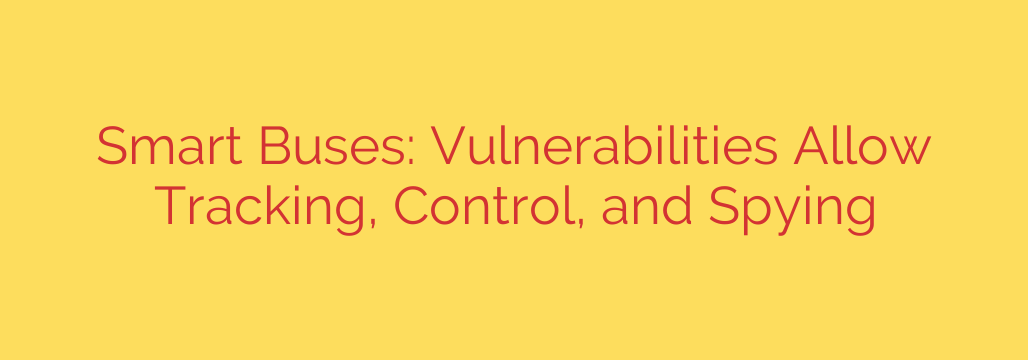
Are Smart Buses Safe? Uncovering Major Cybersecurity Vulnerabilities in Public Transit
Modern public buses are no longer just simple vehicles; they are complex, connected hubs of technology. From real-time GPS tracking and automated passenger counters to onboard Wi-Fi and digital payment systems, this “smart” technology promises a more efficient and convenient experience for everyone. But as our transit systems become more connected, they also become more vulnerable.
Recent security analyses have revealed alarming vulnerabilities within these smart bus systems, exposing potential risks that go far beyond a simple data breach. These security gaps could allow malicious actors to track, control, and even spy on buses, posing a significant threat to public safety and privacy.
The Scope of the Threat: More Than Just Data
The technology that powers a smart bus, often referred to as a telematics gateway, acts as its central nervous system. This unit collects and transmits vast amounts of data, including location, speed, fuel levels, and video feeds. When these systems are not properly secured, they become an open door for hackers.
Here are the critical vulnerabilities that have been identified:
Attackers can gain full access to sensitive fleet information. This includes the real-time location of every bus in a city’s fleet, driver identification details, and detailed route histories. Such access could be used to orchestrate criminal activity or create logistical chaos by feeding false information to transit authorities.
Onboard systems can be remotely manipulated. Hackers could potentially take control of various bus functions. This includes altering the text on internal and external display signs to show misleading or alarming messages, or even accessing the bus’s internal network. In worst-case scenarios, this could extend to interfering with systems that control doors or other operational components.
Engine shutdown and control are a disturbing possibility. Some of the most severe vulnerabilities allow for the ability to send commands directly to the vehicle’s CAN bus, the network that controls core functions. This means a remote attacker could potentially shut down the engine of a moving bus, creating an incredibly dangerous situation for passengers and other road users.
Passenger and driver privacy can be completely compromised. By exploiting security flaws, attackers can gain access to live video and audio feeds from onboard cameras and microphones. This allows for unauthorized spying on private conversations and constant surveillance of everyone inside the bus, representing a massive breach of privacy.
How Are These Systems So Vulnerable?
The root of the problem often lies in basic cybersecurity oversights. Many of these sophisticated telematics systems are deployed with glaring security holes that are well-known in the tech world.
Key issues include:
- Default Credentials: Systems are often installed using factory-default usernames and passwords that are publicly known or easy to guess.
- Lack of Encryption: Sensitive data, including login information and operational commands, is frequently transmitted in plain text without encryption, making it easy to intercept.
- Exposed Systems: Many of these gateways are directly accessible over the internet, allowing anyone with the right knowledge to attempt to connect and exploit them.
Securing Our Transit: Actionable Steps for a Safer Ride
The convenience of smart transportation cannot come at the cost of safety and security. It is crucial for transit authorities and technology manufacturers to take immediate and decisive action.
Here are essential security measures that must be implemented:
- Enforce Strong Security Policies: Immediately change all default passwords to unique, complex credentials. Implement multi-factor authentication wherever possible to add another layer of security.
- Isolate Critical Networks: A bus’s operational network (controlling the engine, brakes, and doors) should be completely separate from its public-facing network (like passenger Wi-Fi). This practice, known as network segmentation, prevents a breach in one area from affecting critical systems.
- Mandate Encryption: All data transmitted to and from the bus must be encrypted using robust, up-to-date standards. This protects sensitive information from being intercepted and read by unauthorized parties.
- Conduct Regular Security Audits: Transit authorities should partner with cybersecurity experts to perform regular penetration testing and vulnerability assessments on their fleets to identify and fix weaknesses before they can be exploited.
- Demand Security by Design: Manufacturers must build security into their products from the ground up, rather than treating it as an afterthought. Secure development practices are essential for the future of connected vehicle safety.
As our world becomes increasingly connected, we must remain vigilant. The technology in our public transit systems offers incredible benefits, but we have a shared responsibility to ensure it is implemented safely and securely. The safety of millions of passengers depends on it.
Source: https://securityaffairs.com/181045/hacking/smart-buses-flaws-expose-vehicles-to-tracking-control-and-spying.html








